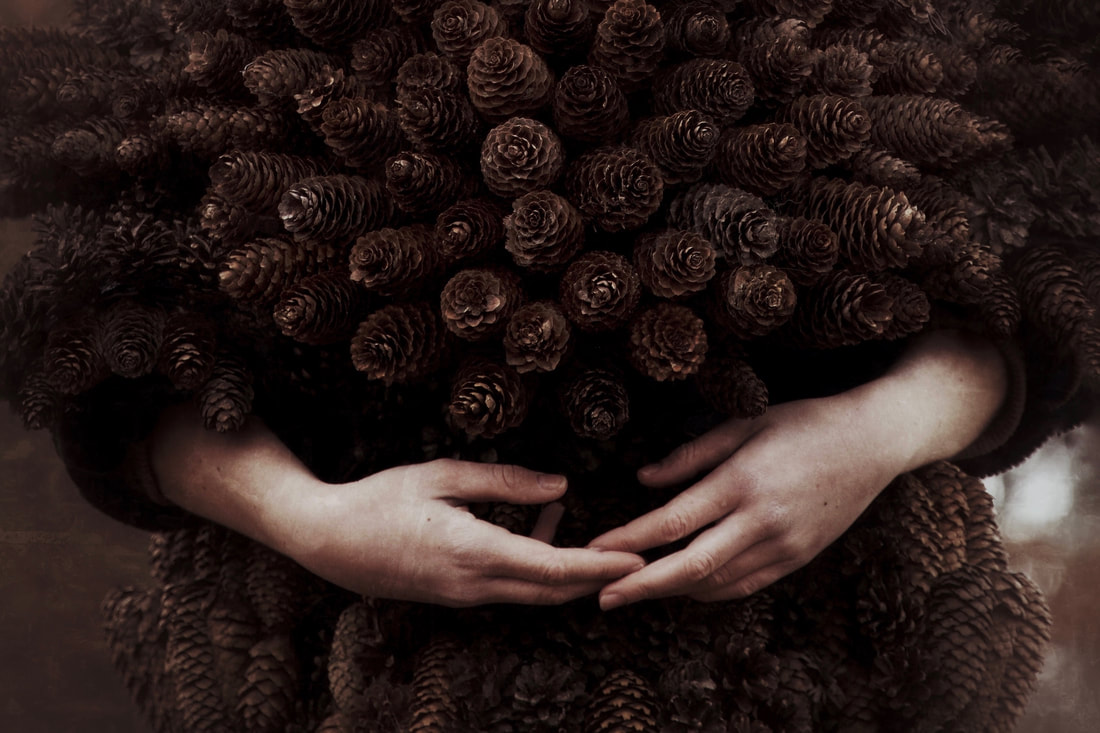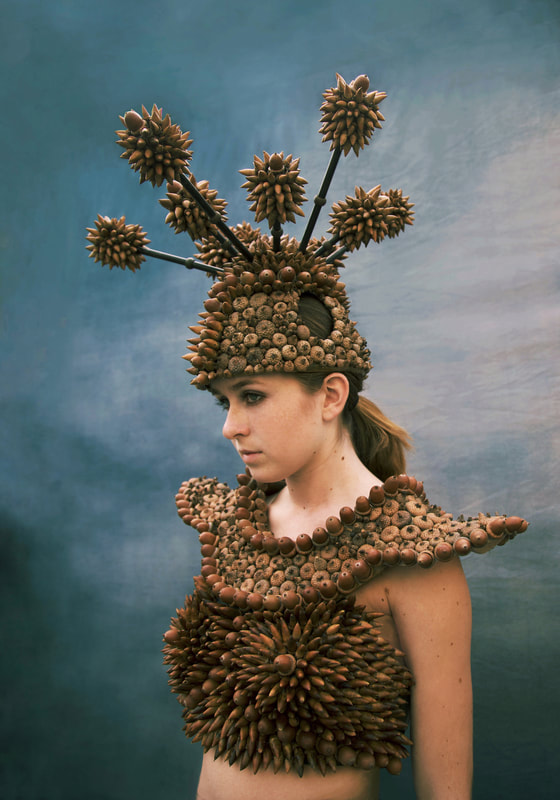By C.T. Lisa | July 2022
Drawing upon Carnival and Native American skin-walkers, Swiss Brazilian artist Melissa Meier uses leaves, stones, eggshells, rice, quills, and pinecones to create breathtaking kinetic sculptures. The warrior women in her Skins series exemplify strength, beauty, and harmony with the elements. Here, Meier discusses her artistic practice—the ephemeral process of working with environmental materials to bridge the divide between humanity and nature.
You work in portraiture, sculpture, costume design, and visual poetry, to name a few. Is there a specific discipline you see yourself most closely working in?
This is always a hard question for me to answer since I don't want to be categorized as doing one thing in particular. I do like the “visual poetry" description though! I think I’m always trying to express a mood or tell a story with my art, no matter what the medium.
I am drawn to sculpture, but photography became an important part of my process, because it was critical for me to capture the work before it decomposed. Having my art worn also excites me because it comes to life—offering an additional layer of narrative. Recently, I have begun to incorporate film and am excited by the combination of movement and music.
I am drawn to sculpture, but photography became an important part of my process, because it was critical for me to capture the work before it decomposed. Having my art worn also excites me because it comes to life—offering an additional layer of narrative. Recently, I have begun to incorporate film and am excited by the combination of movement and music.
Was there anything in particular that set you on the path to becoming an artist?
I have always done art and can’t remember a time when it wasn't an important part of my life. If you were to ask my mother, she would pull out drawings I made when I was a toddler. She saw something early in my work and has been incredibly supportive—even today. I also think that being brought up in a rich culture like Brazil—experiencing its nature, Carnival, and spirituality, as well as traveling the world at a very young age—influenced my art tremendously. And of course, I’ve had some amazing art teachers; they believed in me and motivated me to keep doing what I do.
With the Skins series, you were inspired by indigenous myths, as well as fashion and costume design. How do you see these ideas being interrelated?
My Skins inspiration came from Brazilian Carnival and Native American skin-walkers. I was brought up seeing beautiful parades of costumes in Brazil as a child. These parades sometimes take more than a year to organize and create. There was something so magical and powerful about watching these shows.
I was also inspired by legends of indigenous people and how they used the skins of animals to transform into them, creating a bridge between the human and animal worlds. I wanted to create my own bridge with organic materials and watch the work come to life on the human body. As my work evolved, I became equally interested in the future of fashion as an extreme form of kinetic sculpture.
I was also inspired by legends of indigenous people and how they used the skins of animals to transform into them, creating a bridge between the human and animal worlds. I wanted to create my own bridge with organic materials and watch the work come to life on the human body. As my work evolved, I became equally interested in the future of fashion as an extreme form of kinetic sculpture.
Was there anything particularly labor-intensive about putting Skins together that differed from your previous work?
Skins was different because I was using fragile, organic materials that have limited life spans before they start to decompose. The hardest and most frustrating part of Skins was just trying to preserve the art as I continuously fixed and refreshed it. Actually, I have a love/hate relationship with the process: I love that the materials are organic and they will return to their original state when I am done. But I hate the delicate nature of the construction, that the materials are always in a state of flux and disarray. It’s for this reason that my photography—the documentation of the art—is so important.
Do you spend a lot of time planning pieces before execution? Do you have a team or do it yourself? Planning is an extremely important part of my process, since the work is exceedingly time-consuming. Because I do it all by myself, there is little margin for error—a failed piece can cost a month of lost time. I don’t mind not having a team, because the process is personal and spiritual to me. My family helps during my photoshoots: my daughter is often my go-to model, and my husband and son help with the logistics of the staging and set up.
What is the most fun part of your process?The most exciting part of my process is seeing the work come to life on a model. The second most exciting part is taking the photo and capturing that exact moment.
Is there anything new out there you’re particularly excited to explore?There are many other organic materials I would like to add to the Skins series, such as beans, hair, fiber, ice, and charcoal. I am also interested in constructing imaginary animals from other worlds.
|
Your art is gorgeous and definitely has an edge to it—sometimes playful, sometimes dark. How do you find balance in your compositions?
The materials I use often dictate what mood the piece is going to have, and I spend a lot of time “getting to know” the traits and characteristics of the material before I begin the construction process. It’s a challenge, because the material is always different in shape, fragility, and texture, and I have to know its limitations before I can actually make something out of it. This part of the process is incredibly exciting. It’s when I’m starting to discover, appreciate, and become a part of the art. It’s wonderfully meditative. By the time a piece is completed, I have become an expert with the material.
One additional note is that I research all of the materials I use to see how they have been incorporated and symbolized in different cultures, both old and new.
One additional note is that I research all of the materials I use to see how they have been incorporated and symbolized in different cultures, both old and new.
What advice do you have for emerging artists and writers trying to sustain a creative practice? I think the most important thing I learned in my career as an artist is that one needs to be disciplined, curious, and excited to take risks. I make art every day, even when I am not in the studio. If I can’t physically make something, I'm thinking about or sketching ideas. Curiosity opens one’s mind to discovery. To me, making art is like exercising or eating.
And taking risks and not being afraid to fail is equally as important. So many of my ideas come from making mistakes. I think a lot of artists find something that they’re good at but never break away from it. For me, growth happens when I challenge myself. How did you hear about MASKS?Through artist Miya Turnbull. She was featured in your magazine, and I greatly admire her work. We are both part of Fashion for Bank Robbers’ Patreon group, and she mentioned what a wonderful experience she had collaborating with the magazine.
|
Where else can we find your work?
I will be having a solo show at the Oceanside Museum of Art in March 2023 in Oceanside, California. It will be curated by Kate Stern. I am hoping to not only display my wearable art and photography, but also fantastical animals and natural environments. www.melissameierart.com | Instagram @melissameierart












